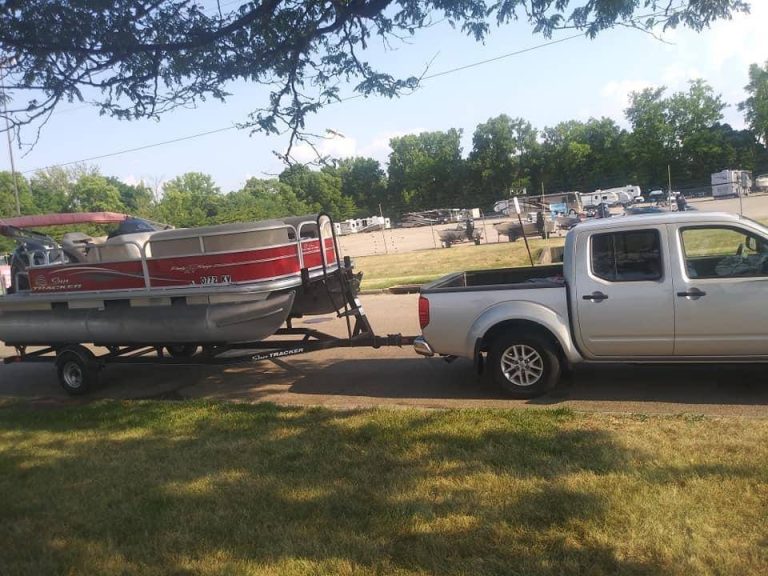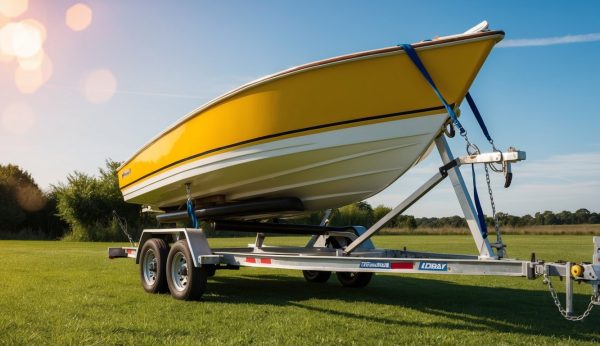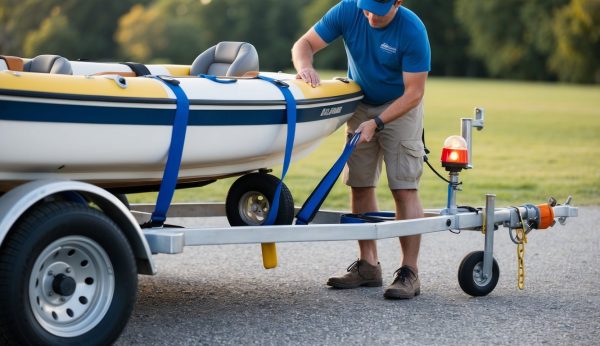Shipping a dinghy can be a straightforward process when you have the right paperwork ready. Whether you’re relocating or just purchased a new tender for your main vessel, proper documentation ensures your small boat arrives at its destination without legal complications.
You need specific documents including proof of ownership, registration, and sometimes permits to legally transport your dinghy across state lines or international borders. Understanding these requirements ahead of time helps you avoid delays and additional costs during the shipping process. Preparation is key to a smooth transportation experience.
Proof of Ownership
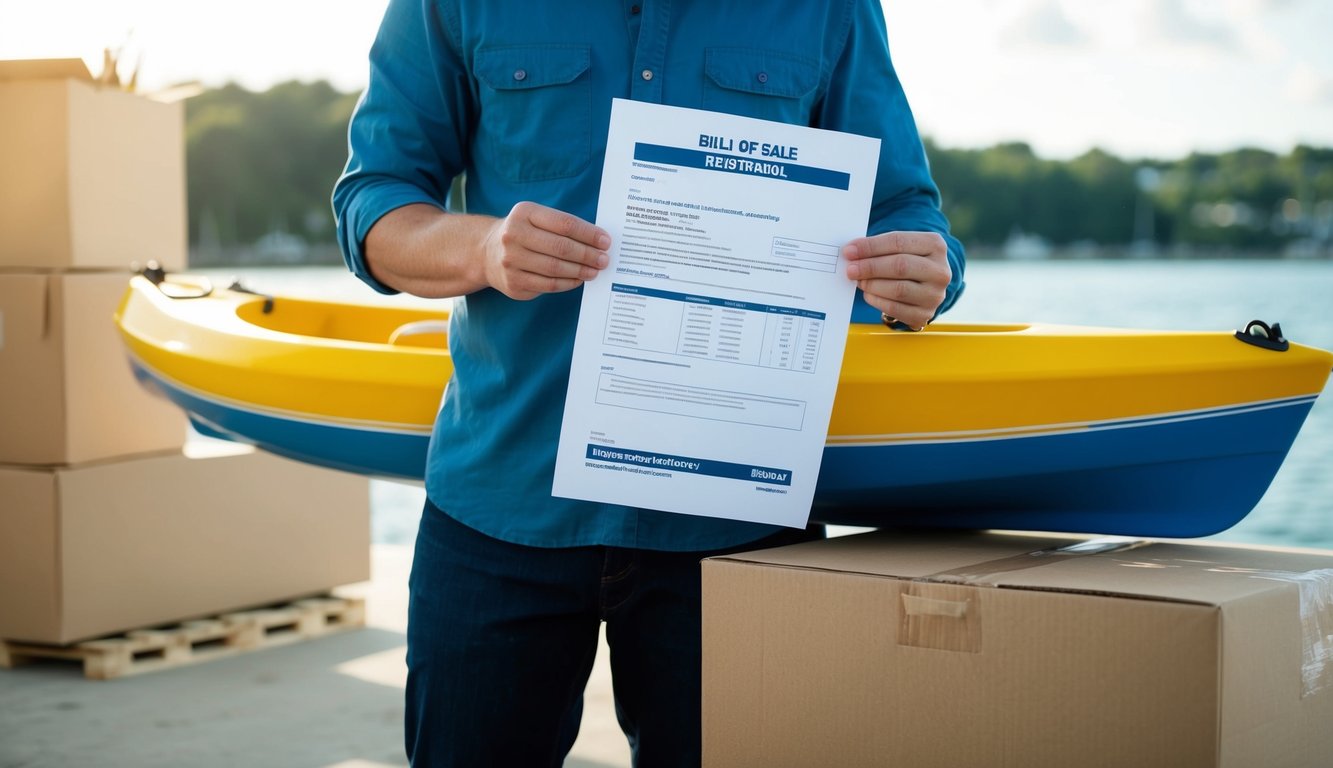
- When shipping a dinghy, proving you own the boat is essential. You’ll need documentation that clearly establishes your ownership before any transport company will move your vessel.
- The most common proof of ownership is a boat registration document. In most states, even small dinghies require registration through your state’s Department of Natural Resources or similar agency.
- If your dinghy was purchased new, you might have a Manufacturer’s Certificate of Origin, which serves as proof of ownership. This is particularly important if you bought your boat outside the US.
- A bill of sale is another crucial document for proving ownership. This receipt shows the transfer of the dinghy from the previous owner to you and should include both parties’ information and signatures.
- For larger dinghies that qualify as documented vessels (typically over five net tons), you might have a USCG Certificate of Documentation that establishes both ownership and nationality of your vessel.
- Always keep these ownership documents in a safe place and make copies before shipping. Most transport companies require proof of ownership as part of their standard procedures.
Bill of Sale

- A bill of sale is a crucial document when shipping a dinghy. This legal paper proves you’re the rightful owner and provides details about the transaction between you and the seller.
- Your bill of sale should include the names and full addresses of all parties involved in the transaction. This creates a clear record of who bought and sold the dinghy.
- The document must contain specific information about your vessel. Include details such as the make, model, year, and any identification numbers like a VIN or hull ID number.
- You’ll need to clearly state the purchase price on the bill of sale. This helps establish the value of the dinghy for registration and potential tax purposes.
- The date of the sale should be prominently displayed. This indicates when the transfer occurred and establishes when ownership officially changed hands.
- Make sure both buyer and seller sign the document. Some states may require additional witnesses or even notarization to make the bill of sale legally binding.
- Keep the original bill of sale in a safe place. You’ll likely need to present it when registering your dinghy or when arranging for its shipment.
Registration Documents

- When shipping a dinghy, you need to have the proper registration documents ready. All dinghies must be registered in your home state or state of principal use. This is a requirement from the U.S. Coast Guard.
- You should carry your boat’s certificate of number (registration) with you. This document proves that your vessel is properly registered with the appropriate authorities.
- If your dinghy is being transported as a tender to a larger documented vessel, you still need state registration. The documentation of the main vessel does not extend to the dinghy.
- For registration, you’ll typically need to complete an application through your county clerk’s office. The exact requirements vary by state, so check your local regulations.
- Many boaters debate whether to carry original documents or copies. While some suggest copies are sufficient, it’s safest to have originals available, especially when shipping your dinghy across state lines.
- Make sure your dinghy displays the registration numbers properly and has current state use stickers as required by law.
USCG Certificate of Documentation

- A Certificate of Documentation is a federal form of registration issued by the U.S. Coast Guard. Not all dinghies require this document, as it’s mainly for vessels measuring at least five net tons.
- To obtain documentation for your dinghy, you must be a U.S. citizen, and the vessel must meet the minimum size requirements. This documentation offers several benefits, including easier financing options and the ability to travel internationally.
- When your dinghy is documented, you’ll receive an official Certificate of Documentation from the National Vessel Documentation Center. This certificate includes your vessel’s official number and other identifying information.
- While you might think you need to carry the original certificate onboard, you can actually keep a copy of the documentation on your dinghy instead of the original paperwork. This protects the original from water damage.
- Documentation typically needs to be renewed annually. You can submit your initial documentation or renewal through the National Vessel Documentation Center.
State Registration Stickers
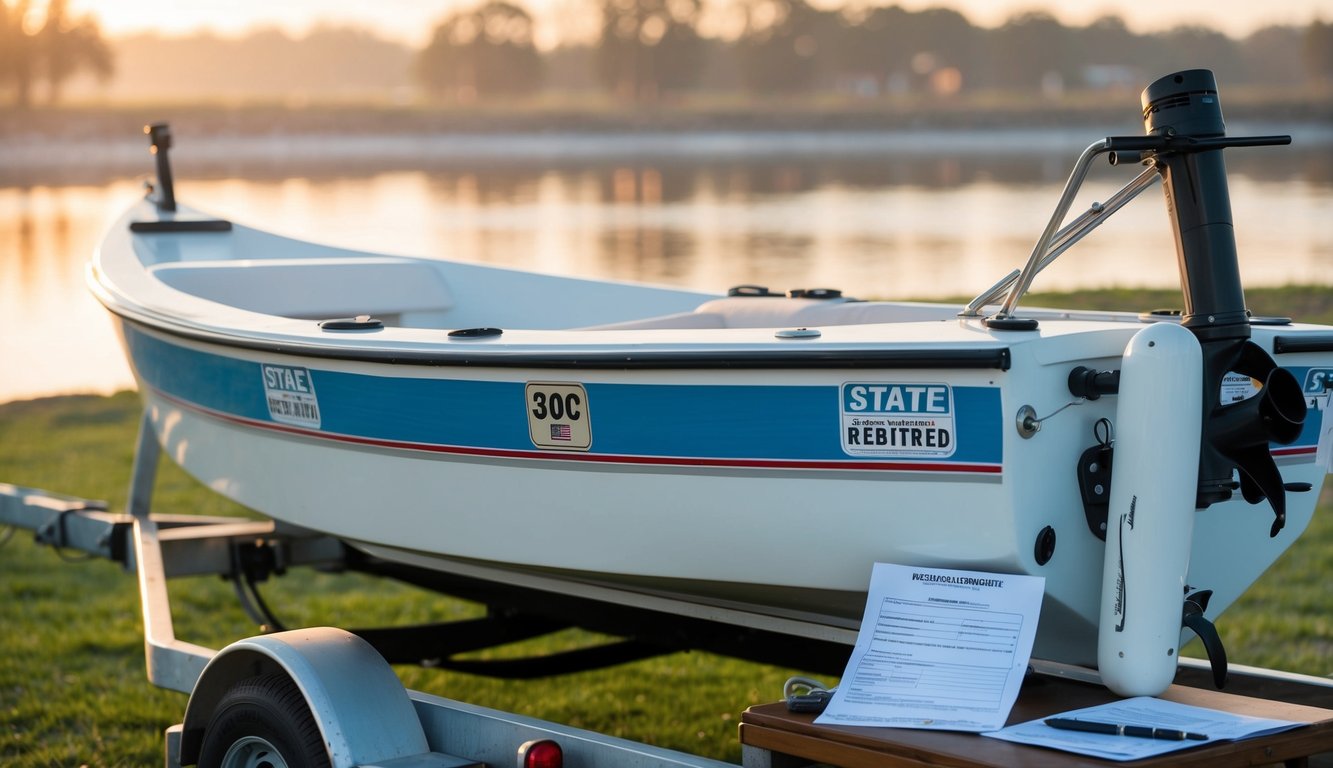
- When shipping a dinghy, you’ll need to ensure your state registration stickers are properly displayed. Most states require boats to display registration numbers and current validation stickers, even on small dinghies.
- State registration requirements vary depending on where you live. In Illinois, for example, you must complete a Watercraft Registration/Title Application before shipping your dinghy to a new location.
- If you’re shipping your dinghy to a new owner in another state, you may need to order a duplicate title to facilitate the transfer. This ensures the new owner can properly register the vessel in their state.
- Before shipping, check that your registration stickers are current and visible. Expired registration could cause complications during transport or at the destination.
- You should place registration stickers according to your state’s regulations. Most states require them on both sides of the bow, but specific placement rules can differ.
- If you’re shipping internationally, different documentation may be required beyond state registration stickers. Check with customs authorities at your destination for specific requirements.
Permits for Transport

- When shipping a dinghy, you need specific permits for safe and legal transport. These permits ensure compliance with state regulations and avoid potential fines.
- For standard-sized dinghies, general transport permits are often sufficient. You can obtain these through your state’s Department of Transportation or Department of Natural Resources.
- Oversized dinghies may require special permits. If your boat exceeds standard width limits (typically over 8.5 feet wide), you’ll need an oversize boat shipping permit.
- Different states have varying requirements. Be sure to check regulations for every state your dinghy will travel through, not just your departure and arrival points.
- Permit costs range from $15 to $70 depending on your location and dinghy size. Processing time typically takes 3-5 business days, so plan accordingly.
- You’ll need to provide proof of ownership such as registration documents when applying for transport permits. Keep these permits visible during transport.
- For interstate transport, federal permits may apply in addition to state requirements. Check with your transport company as they may handle this paperwork for you.
Insurance Documentation

- When shipping your dinghy, you’ll need to have proper insurance documentation ready. Most shipping companies require proof of insurance before they will transport your boat.
- Keep a copy of your boat insurance policy and contact details for your insurer. Many marinas, boatyards, and shipping companies need to see this information before handling your vessel.
- Your insurance paperwork should clearly show coverage for transit or shipping. This protects your dinghy during the loading, transport, and unloading processes.
- Make sure your policy hasn’t expired and the coverage amount meets the shipping company’s requirements. Different companies may have different minimum coverage requirements.
- You should include both liability and comprehensive coverage in your documentation. This ensures protection against damage to your boat and potential damage to other property during shipping.
- Consider making multiple copies of your insurance documents. Keep one set with your personal records and another with the shipping paperwork.
- Remember that original documentation is often preferred over photocopies. Check with your shipping provider about their specific requirements for insurance verification.
Original Vessel Documentation

- When shipping a dinghy, you might need to consider vessel documentation from the U.S. Coast Guard. This documentation serves as a form of national registration.
- Not all dinghies require documentation. Generally, only vessels measuring 5 net tons or more need this paperwork, which excludes most small dinghies.
- If your dinghy does qualify, you’ll need to provide proof of ownership such as a bill of sale, builder’s certification, or first transfer of title.
- The documentation must include a complete description of your vessel. This includes the manufacturer’s name, year, type, hull material, propulsion, and fuel type.
- Your application should also include the Hull Identification Number (HIN), which is unique to your vessel.
- You can process documentation directly through the Coast Guard’s National Vessel Documentation Center. They provide all necessary forms online.
- Keep in mind that documented vessels must display their name and hailing port. The hailing port must include the state, territory, or possession where it’s located.
Valid Identification of Owner
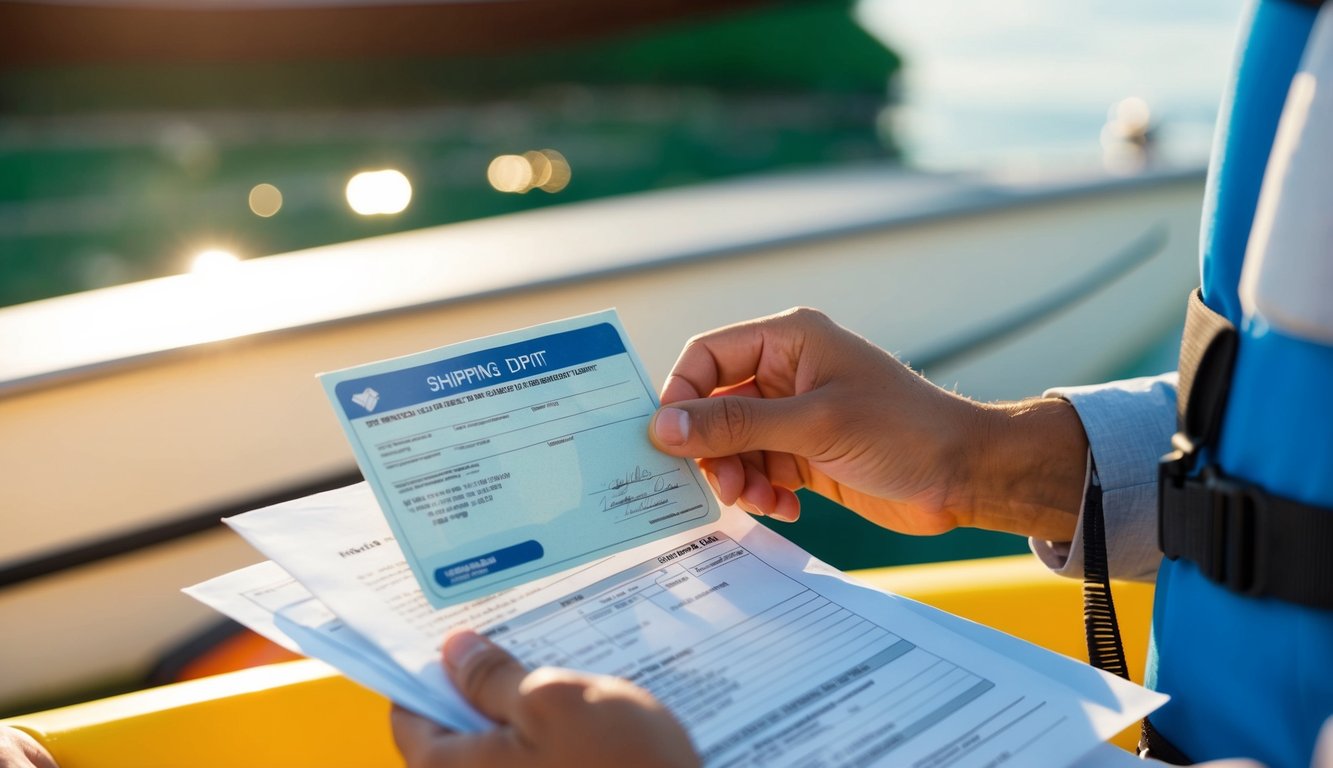
- When shipping a dinghy, you must provide valid identification to prove you’re the rightful owner. Government-issued ID is essential for this process.
- Each owner listed on the registration must submit a signed photocopy of their valid government-issued identification. This typically includes a driver’s license, passport, or other official ID.
- If multiple people own the dinghy, all owners must provide their identification documents. This helps prevent fraud and ensures the vessel is being shipped by authorized individuals.
- Your identification documents need to be current and not expired. Make sure the name on your ID matches exactly with the name on other ownership documents.
- Some shipping companies may require notarized copies of your identification for added security. Check with your shipping provider about their specific requirements before preparing your documents.
- Keep copies of all identification documents you submit. This creates a paper trail that can be useful if questions arise during the shipping process.
Local Tax Receipts

- When shipping a dinghy, you need to keep track of local tax receipts. These documents prove you’ve paid all required taxes on your boat. Tax requirements vary by location.
- In some states, you’ll need to show proof of payment for sales tax when shipping your dinghy. Keep all receipts, invoices, and statements related to the purchase.
- For larger dinghies that qualify as a second home, tax implications may differ. The IRS considers a boat a second home if it has a bathroom, sleeping area, and kitchen. This may affect your shipping documentation needs.
- Some states offer partial sales tax exemptions for boats. If you’ve received such an exemption, include this paperwork when shipping your dinghy.
- Always request itemized receipts when buying boat-related items. Trailer prices should be separately stated on invoices to avoid paying full sales tax on the entire purchase.
- Keep digital copies of all tax documents. This makes them easy to submit when arranging shipping and may also help with future boat documentation renewals.
